Justice and the Courts
Probation reforms temporarily tabled
June 22, 2010
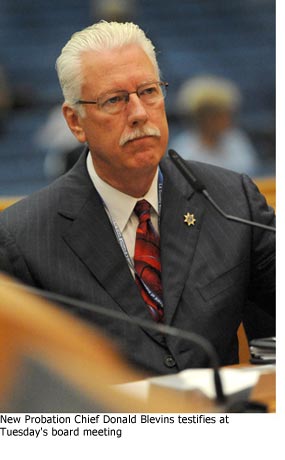 A series of measures aimed at swiftly improving the management and accountability of L.A. County’s scandal-plagued Probation Department was put on hold Tuesday when a short-handed Board of Supervisors could not muster the three votes needed for passage.
A series of measures aimed at swiftly improving the management and accountability of L.A. County’s scandal-plagued Probation Department was put on hold Tuesday when a short-handed Board of Supervisors could not muster the three votes needed for passage.
The matter was delayed a week after Supervisor Mark Ridley-Thomas—one of only three members present—left the board one vote shy by abstaining. Supervisors Zev Yaroslavsky and Gloria Molina, both of whom have been outspoken in their efforts to reform the department, had voted to move the measures forward.
Ridley-Thomas declined Molina’s offer to explain why he abstained at a time when the department is under increasing pressure to quickly restore public confidence. “I don’t know why anybody would object to these…motions,” said Molina, the board chairman. In fact, Supervisor Michael D. Antonovich, who is out of town, had encouraged his board colleagues in an e-mail to press ahead, despite his absence. He called the motions “vital.”
In recent weeks, the 6,000-person department has been rocked by disclosures, including reports that employees used county credit cards to buy electronics goods, that dozens of employees accused of misconduct may escape discipline because the investigations ran too long and that the department cannot fully track $79 million allocated by the Board of Supervisors to hire personnel.
The three motions at issue on Tuesday were intended to provide the department’s newly named chief, Donald Blevins, with ways to increase the effectiveness of his management team and provide tougher oversight of the department’s internal investigations and discipline.
Two of the motions were co-authored by Yaroslavsky. One, written with Antonovich, would expand the responsibilities of the Office of Independent Review to include oversight of the Probation Department. For nearly a decade, the OIR’s work has been largely confined to monitoring the operations of the Sheriff’s Department.
The second motion—this one co-authored with Molina—asks the CEO, County Counsel, personnel officials and others to explore within 30 days how Blevins could, under Civil Service rules, begin hiring managers from outside the Probation Department—a break with current practices.
The third motion, authored by Supervisors Antonovich and Don Knabe, attempts, among other things, to insure that that no employees in the future escape discipline because of unnecessarily long internal investigations and that probation officials responsible for such lapses in the past be held accountable.
At Tuesday’s meeting, Yaroslavsky emphasized that “time is of the essence”—a sentiment that brought agreement from Blevins, the former probation chief of Alameda County. He said he understands the board’s “clear message” that it’s his job “to clean up the department.”
Posted 6/22/10
Pushing for change in Probation Dept.
June 17, 2010
Outraged by a continuing stream of revelations, the Board of Supervisors is set to consider two measures aimed at intensifying oversight and accountability in the county’s Probation Department, which has been rocked by financial lapses and management failures.
In recent months, the 6,000-person department has been embarrassed by disclosures that it was unable to account for the expenditure of $79 million dollars allocated by the board, that probation youth had been allowed to conduct videotaped boxing matches in Juvenile camp classrooms and that more than two dozen officers accused of serious misconduct could escape discipline because the investigations exceeded a one-year statute of limitations.
Moreover, it was disclosed this week that the county’s Auditor-Controller has uncovered numerous instances in which Probation employees may have used department credit cards to illegally purchase electronics and other items for personal use. A criminal investigation has been initiated.
“The Probation Department has lost its sense of mission,” concluded Supervisor Zev Yaroslavsky. “The mission became more about them than about the clients they serve.” In an effort to get the department back on track, Yaroslavsky has co-authored two motions scheduled to come before the board on Tuesday.
One, with Supervisor Michael D. Antonovich, would expand the responsibilities of the Office of Independent Review to include oversight of the Probation Department. For nearly a decade, the OIR’s work has been largely confined to monitoring the operations of the Sheriff’s Department. In March, however, the board asked the OIR to examine the Probation Department’s internal investigations. OIR concluded that sweeping reforms were needed. Yaroslavsky and Antonovich are pressing for the OIR to assume those duties.
The second motion—this one authored with Supervisor Gloria Molina—is aimed at giving newly-appointed Probation Chief Donald Blevins greater latitude in assembling a “competent and effective” team of leaders. To that end, the motion asks the CEO, County Counsel, personnel officials and others to explore within 30 days how Blevins could, under Civil Service rules, begin hiring managers from outside the Probation Department—a break with current practices.
This hiring shift is considered crucial for Blevins, who says he is determined to weed out bad managers and reform the agency from top to bottom. In a statement to the media on Wednesday, Blevins warned:
“It is my responsibility to investigate the allegations of fraudulent activities that are said to be taking place and I assure you, those who have violated my trust, will be punished and/or removed from this Department. I have a zero-tolerance for misbehavior within my organization. The standard level that I hold every single employee within this Department is that of professionalism and high personal integrity. If this is too much for any employee to handle, then perhaps they made a poor career choice. These are sworn officers and they must act accordingly.”
For an interview with Blevins shortly after he was hired in April, click here
Posted 6/17/10
‘Shocking’ accounting mess at probation
June 7, 2010
Over the past five years, the Board of Supervisors has allocated $79 million to the county’s Probation Department to improve its juvenile facilities and reorganize its management structure.
The question on Tuesday: Where’d all that money go?
In a report to the board that triggered sharp reactions, the Chief Executive Office acknowledged that it could not definitively determine whether probation officials had spent the funding for its intended purposes—including the hiring of 901 employees—“because of the inadequacy of the department’s records.”
“The depth of the problems in this department are shocking,” Chief Executive Officer William T Fujioka told the supervisors.
Fujioka’s statements drew strong criticism from the supervisors, who for months have expressed concern about why the department was continuing to compile deficits when the board had provided so much money. In April, voting on a motion by Supervisors Zev Yaroslavsky and Don Knabe, the board directed the CEO to investigate the matter, leading to Tuesday’s report, which fell far short of the answers the board wanted to hear.
“Seventy-nine million is allocated to this department and nobody knows where it went?” Yaroslavsky asked incredulously during Tuesday’s board. Criticizing both the department and the CEO’s office for the slowness of the inquiry, he added: “This sounds to me like it is a colossal mess.”
Supervisor Gloria Molina didn’t pull punches, either.
“If it was your own checkbook that was paying for this, believe me you’d be up all night along trying to figure out where it’s going,” she said, questioning whether staffers were working intensely enough to find the answers.
Molina also raised the possibility that the lack of records leaves open the possibility that the department has hired “ghost employees” who don’t really exist or employees who collect paychecks but don’t actually show up to work.
At the end of the heated discussion, the board, frustrated by what it considered the slow pace of the inquiry, approved a motion by Supervisor Mark Ridley-Thomas to bring the Auditor-Controller’s Office on board. The CEO, Probation and Auditor-Controller will report results back to Supervisors in early July.
Most of the $79 million had been allocated to bring the Probation Department into compliance with mandates issued in 2004 by the U.S. Department of Justice, including a directive to improve client-to-staff ratios and increase personnel for health and mental health care. In all, 901 employees were to be hired.
But the Probation Department has been unable to provide a full accounting of the personnel.
 A recent spot check of staffing at the department’s Downey headquarters using payroll data showed that the department’s records do not accurately reveal the location of the new workers. Chief Probation Officer Donald Blevins, who arrived in April and was charged by the supervisors with fixing longstanding problems, said that 146 of the 548 staffers nominally working at headquarters were actually assigned to another office, despite records to the contrary.
A recent spot check of staffing at the department’s Downey headquarters using payroll data showed that the department’s records do not accurately reveal the location of the new workers. Chief Probation Officer Donald Blevins, who arrived in April and was charged by the supervisors with fixing longstanding problems, said that 146 of the 548 staffers nominally working at headquarters were actually assigned to another office, despite records to the contrary.
He extrapolated that up to 2,000 of the department’s 6,100 employees may work at locations other than those shown in Probation records and promised he’d continue to “aggressively [track]” the locations of all employees.
Blevins and the CEO also noted that they believe newly hired employees were working in the areas intended because the department had satisfied the Justice Department’s issues. “But we cannot report with certainty which positions were hired, or where those staff were deployed at the time,” the CEO’s report.
The report did disclose two funding problems in which money intended to solve particular issues did not reach the intended target.
In 2008-9, supervisors appropriated $6.5 million toward the purchase of a medical records system called PEMRS, but spent only $500,000 on the program. The other $6 million helped offset the department’s deficit that year. The supervisors had to allocate another $6 million the following year to buy the records system.
In addition, about $2.5 million earmarked for rents in 2008-2009 was apparently applied to the department’s deficit.
During Tuesday’s discussion, Molina told Blevins, the new probation chief, “we’re not blaming you, because we know you inherited it. But we’re asking you to really take command of it.”
Blevins, for his part, assured the supervisors that he was doing his best to account for the department’s funds and personnel.
“We are aggressively tracking this,” Blevins said.
Posted 6/7/10
Keeping scammers on the run
February 25, 2010
The case may be over, but L.A. County’s real estate fraud investigators are still plenty busy.
Last week, a federal judge sentenced five defendants—including two who drew double-digit prison terms—in a $13 million real-estate fraud case in which the FBI and federal prosecutors received key assistance from investigators of the Real Estate Fraud and Identity Theft unit of the county Department of Consumer Affairs.
Pulling together property and loan records for dozens of fraudulent home-loan transactions, the county investigators “provided invaluable information and assistance” to federal prosecutors, said Thom Mrozek, spokesman for the U.S. Attorney’s Office in Los Angeles.
That assistance helped put Martha Rodriguez, of Downey, and Ed Seung Ok, of Huntington Beach, in prison for 10 and 15 years respectively, following guilty pleas on mail fraud and money laundering charges.
The Silvernet scam, named for Rodriguez’s real-estate firm, ran between 2003 and 2005 and it involved convincing owners of homes in default to sign over their home’s title to a “co-signer” with better credit so they could get a new, bigger mortgage on the house. But instead of giving the new loan to the family, Rodriguez and Ok pocketed most of the proceeds themselves, defrauding the banks and leaving the homeowner with no title, mortgage or right to their home.
Now that the case is over, the fraud unit is beginning to help about 30 victims of the scam pick up the pieces by, among other things, helping the victims negotiate with lenders to regain title of their homes.
“We’re telling people if you are still in this mess, we want to work with you to determine what your best options are,” Acting Consumer Affairs Director Rigo Reyes said. (Click here to learn more about the department’s homeowner services.)
Helping federal prosecutors is a small part of the work of the five-person anti-fraud team, headed by supervising investigator Dawnnesha Smith. In some cases, the investigators resolve complaints through negotiation. In cases that look criminal, investigators refer cases for prosecution to the district or city attorneys’ offices.
Since the collapse of the real-estate market, the sheer volume of complaints has spiked dramatically. “We’re seeing at least double the number of cases since 2007,” up to about 300 real-estate-related complaints each month, Smith said. In addition, the unit recently took over investigations of credit-card theft and other identity fraud.
Hoping to protect the public against scams, Smith said, “we do a lot of work explaining real-estate fraud in speaking engagements.”
The unit’s work is drawing attention from county officials. Reyes and Smith learned Wednesday that the unit won a 2009 SUPERSTARS! Award from the county for “service excellence and organizational effectiveness.” The members are scheduled to be honored at the May 11 meeting of the Board of Supervisors.
The Rodriguez-Ok prosecutions represented the first time the county investigators had teamed up with federal authorities. Since then, they’ve participated in another case, helping federal prosecutors investigate a $1 million real-estate scam in East Los Angeles that resulted in the 2009 conviction of Juan Rangel on charges that he bribed a bank manager so he could stash huge cash payments in his bank account.
Smith’s team is now busy chasing “foreclosure consultants” who prey on homeowners who have defaulted on their mortgages. The scammers charge up-front fees ranging from $1,000 to $10,000 with the promise that they will renegotiate the owner’s mortgage with the bank. Then they’d run off with the money, leaving bewildered homeowners in even deeper trouble than before.
Smith said her investigators have learned of a new scam that exploits public skepticism about banks. “We’ve noticed companies sending out notices saying ‘Your lender is under investigation. Call us to modify your loan’,” Smith said, adding of the new schemes: “It’s ever evolving, and we have to stay ahead of it.”
Posted 2/25/10
Inmate firefighters get home beyond Malibu
February 3, 2010
In a deal that will be welcome news to Malibu homeowners, the Los Angeles County Fire Department has struck a three-year agreement to house fire teams staffed with state prisoners at a juvenile probation camp in the Angeles National Forest.
The agreement ends the Fire Department’s search for a long-term home for the crews, a quest that sparked protests in mid-January when word leaked that a fire station in the Rambla Pacifico area of Malibu was being eyed as a possible replacement for a fire camp that burned during the Station Fire in August.
Angry neighbors complained that housing the inmates so close to their homes posed a safety risk. The residents also argued that with only one narrow street providing access, traffic from visiting inmate families would be a mess.
Within days of the uproar—some of it based on misinformation—the Fire Department announced it was scrapping the Malibu option.
Under the terms of the new agreement, about 90 state inmates whose fire camp on Mt. Gleason, known as Camp 16, was destroyed last summer will be housed at the Probation Department’s 30-year-old Camp Holton, in the Big Tujunga Canyon, east of Sylmar. The men already had been staying at the facility on a temporary basis since shortly after the fire, which killed two County firefighters.
“This long-term arrangement,” Fire Chief P. Michael Freeman said in a statement, “satisfies the immediate need of the Los Angeles County Fire Department and assures the residents of Los Angeles County that these crews will have an appropriate facility.”
Chief Probation Officer Robert Taylor added: “The overriding issue for both of us was the issue of public safety.”
The fire crews consist of state prison inmates with good behavior records who are serving time for non-violent crimes that include burglary, fraud and DUI offenses. Firefighting inmates have been housed at five locations throughout the county, including a facility for women in Malibu’s Encinal Canyon.
Freeman and Taylor came to terms Tuesday during a meeting at the Probation Department’s Downey offices. How much the Fire Department will pay probation has yet to be negotiated.
In interviews, Freeman and Taylor explained that the arrangement deal to house the inmate crews for a longer stint at the probation camp emerged only recently.
Freeman says his staff conducted preliminary searches at several locations around the county, “but the options were not panning out.” Among those was the Malibu location. Freeman says the department was only scouting potential sites—including the Malibu location—before he was going to approach the state and the community.
The agreement between Freeman and Taylor was reached after it became clear that no other location would work.
Unlikely duo writes new script for inmates
December 28, 2009
As a Hollywood executive, Scott Budnick produces buddy movies with a twist, like “The Hangover,” this summer’s gross-out comedy about the aftermath of a lunatic Vegas bachelor party, which has been nominated for a Golden Globe.
But he’s also starring, albeit far more quietly, in a real-life buddy production.
The high-energy film executive teamed up with a young prison inmate to create a new state program that gives an educational boost to L.A. County juvenile inmates who, at age 18, are facing time in California’s tough adult prisons. Launched last year, the Youthful Offender Pilot Program so far has placed about 50 juvenile offenders in safer settings with better educational and job training programs.
“I love a challenge,” says Budnick, 32. “This is a population that no one really cares about. These guys are demonized, and some people think they can’t be rehabilitated. It’s not true.”
A good number of these young inmates—eight of them—are at the medium security California Rehabilitation Center in Norco, near Riverside, living in a “college dorm” decorated with murals of Albert Einstein and astronaut Neil Armstrong and featuring quiet study rooms.
There, these young charges of the penal system, along with nearly 100 older inmates, have been allowed to participate in an already existing, federally-funded college program for inmates under the age of 35. They take correspondence courses ranging from art to pre-calculus and watch DVD lectures on four new flat screens.
From Budnick, they’ve learned lessons of another sort.
“He don’t have to do none of this for us,” says Michael Tavarez, 18, from La Puente, who arrived at Norco this spring after a conviction for assault with a deadly weapon. “He has his own life, but he’s doing all this just to help us out.”
The idea for the program actually started with an inmate named Prophet Walker, who was sentenced to six years for assault with great bodily harm. He had been one of Budnick’s students in a writing program at Juvenile Hall in Sylmar, where he earned a high school degree.
At 18, Walker was shipped to an adult facility in Blythe, a rough setting for a young guy determined to right his life. Despite the environment, Walker continued to pursue his education and steered clear of the gangs that ruled the roost. After two years of lobbying prison officials, he won a bed in the lower-security Norco and a seat in its coveted educational program.
Given his own experiences, Walker figured there must be some way for other juveniles who’d done well during their incarceration to sidestep the more dangerous adult prisons, which he believed were undermining rehabilitation.
So, in 2008, he turned to Budnick for help. And the executive turned the challenge back on Walker, telling the inmate that, if he came up with a good plan, he’d sell it to prison higher-ups. In fact, Walker came up with a very good plan.
He proposed revamping the scoring system that state correctional officials use to place new inmates in prisons so that it rewarded juveniles who behaved well during their incarceration. Budnick jumped on the idea. A week later he arranged a meeting in Sacramento with Scott Kernan, who oversees inmate classifications for the California Department of Corrections and Rehabilitation as undersecretary for operations.
Kernan was quickly receptive. He shared concerns that younger inmates can get “thrown to the wolves” in tougher, high-security facilities, making rehabilitation even more remote. “We hope this will help avert some of those problems,” Kernan says.
If an inmate and an outsider teaming up for prison reform wasn’t enough of a Hollywood ending, Walker, now 22, earned parole in November after completing an associate’s degree behind Norco’s walls. In January, he’s scheduled to start classes at Loyola Marymount University as an undergraduate engineering student.
“It’s amazing,” Walker says of his accomplishments. “I’m still coming down from the high.”
As for Budnick, he says he’s driven to help the young inmates because most people see them as a “disposable population” best locked up and forgotten.
Budnick, who grew up in a nice Atlanta neighborhood and says he never got in trouble, believes that kids in tougher neighborhoods are afflicted by the same lack of awareness of consequences as teens in more affluent areas. The difference, he says, is that guns are more pervasive in some neighborhoods. “If you grow up like me in the suburbs, the kids get in a fight and it’s not a big deal,” he says. “Here, everyone’s armed, and it takes it to a different level.”
Budnick is president of Green Hat Films, the production company of director Todd Phillips. Besides “The Hangover,” Budnick also has producer credits for “Starsky and Hutch” and “School for Scoundrels.” He’s an executive producer of another upcoming Phillips buddy film, “Due Date” with Robert Downey Jr., which was shooting this fall.
One morning in November, Budnick played hooky from filming at the Ontario Airport to visit his friends at the college classroom at Norco, the sprawling prison that houses 4,680 inmates.
“Molina, you keeping up with your work?” he asks Luis Molina, 20, from Van Nuys. Molina arrived in March, after time at Folsom State Prison for attempted murder and robbery.
“Alfaro!” Budnick greets Anthony Alfaro, 23, from Santa Monica, who entered the program last year and says he is “halfway to an associate’s degree.” Convicted of attempted murder as a teen, he’s now planning on enrolling in college after parole in two years and hopes to get an MBA someday. “I’ve got a lot of ambition,” he says.
Like Walker, Alfaro entered the state prison under the old rules, and was assigned to Centinela State Prison in Imperial County. And, like Walker, he too had known Budnick from the InsideOUT Writers group as a juvenile inmate in L.A. and stayed in touch.One day, he was on lockdown at Centinela when, out of the blue, officials told him he’d just gotten a new deal.
“They said, ‘I don’t know who you know, but you just got a transfer,” Alfaro recalls.
In the classroom at Norco, Budnick praised the inmates’ progress in a macho style that aimed to encourage without being saccharine.
“Hey Van Pelt!” he calls out to Don Van Pelt, the program’s administrator, within Alfaro’s earshot. “I’m shocked these guys know how to do PowerPoint presentations!”
Across the classroom, the intense Alfaro, whose left forearm is covered in tattoos, smiles.
To remain in the program, the students have to complete assignments as well as stay out of fights and gangs. “So far, we have not had any of Scott’s guys kicked out,” says Van Pelt, referring to Budnick.
The young inmates understand that if they foul up they’ll get sent back to the tougher prisons. “Not a lot of good opportunities come in life,” says Gerardo Vasquez, 19, of La Puente, serving time for armed robbery. “Scott gave us an opportunity, so now we got to take it and get the best out of it.”
Jail phone calls ring up big bills
November 2, 2009
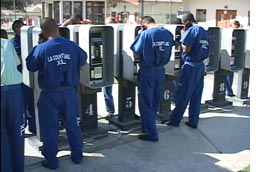 Responding to complaints about the high cost of telephone service in Los Angeles County jails, the Board of Supervisors has moved to open up bidding on the multi-million dollar jail phone contract in an effort to lower the cost of calls while still providing key funding for jail programs.
Responding to complaints about the high cost of telephone service in Los Angeles County jails, the Board of Supervisors has moved to open up bidding on the multi-million dollar jail phone contract in an effort to lower the cost of calls while still providing key funding for jail programs.
The jail phone contract with the Sheriff’s Department governs the rates charged when inmates call family, friends and attorneys from the jails’ nearly 4,100 telephones. The current provider is Global Tel*Link, a privately-held Alabama firm that operates phone services in jails and prison systems nationwide, including many in Southern California.
The contract brings in about $30 million a year. The company keeps 48 percent while paying 52 percent to the Sheriff’s Department, which uses the money to help pay for inmate programs and jail maintenance.
The contract, which runs through December 2010, allows GTL to charge $3.54 for the first minute of a collect local call from the jail, making the average call of 17 minutes a $5.20 expense for the inmate families, according to a 2008 report by the county CEO’s office, prepared for the Board of Supervisors. The county initially cut the deal in 2005 with the then-SBC/AT&T, which later sold its jail business to GTL. Inmates can also buy prepaid phone cards and save 10 percent on calls, but few do.
The rates are among the highest in the region, about 10 to 30 percent above most prices paid in other county jails and many prisons nationally.
GTL says the county negotiated and approved the contract in 2005. The company says comparisons of per-call rates from one jurisdiction to another are unfair. “Variability in rate structures and costs [between counties] is to be expected” because each jail system negotiates prices based on a different menu of services and product features, GTL’s western regional vice president for sales, Michael Palovik, said in an e-mail exchange.
Palovik says GTL prices in L.A. can be as low as $3.35 for the first minute during daytime local collect calls; later minutes can cost as little as $.759 per minute.
The amount of money charged is controversial because studies show that maintaining strong family contact during incarceration through phone calls, correspondence and visits can aid parole success and reduce recidivism.
The supervisors believe it’s possible to get a better deal for both the inmates and the county if several companies vie for the next contract, which begins in January 2011. “The one way you find out about the best deal is you put all the sharks in one tank and let them fight it out,” Supervisor Zev Yaroslavsky said during a board meeting last year.
County CEO William T Fujioka agreed. “I’m absolutely convinced, you put this out on the street, we’re going to get a more competitive contract,” he told Supervisors during the 2008 meeting. “The County wants to achieve two goals. One goal is to lower the rates. The second goal is to make sure that this valuable resource for the Sheriff’s Department is maintained.”
Supervisors rejected a GTL offer to pay the county a $3.5 million fee to extend the current contract through 2013. The supervisors’ goal in putting up the contract for bid is to lower per-call costs to families while maintaining steady revenues for the Sheriff’s Department.
The fund nets about $15 million a year for the sheriff’s Inmate Welfare Fund, which helps supplement the costs of inmate education, drug recovery and training program as well as maintenance programs in the overcrowded jails.
The Sheriff Department’s 52 percent cut is “at the high end of the range” compared to figures paid to other correctional facilities, according to a County CEO’s report last year. Most commission rates, as they are called, fell between 40 and 56 percent.
As his office is preparing the terms of the Request for Proposal, the initial step in soliciting new bids, Sheriff Lee Baca is pushing against any plan that would lower revenues to the department. “I oppose any effort by the Board to alter the rates through a bid process,” Baca told Supervisors in a letter dated September 22.
“We can’t look at this from the perspective that the inmates are overcharged, because they are not,” he told Supervisors at a hearing last year.
The first-minute charge exceeds every Southern California county except Orange County, which charges a flat $4 rate whether the call lasts a minute or an hour. The price of the average Los Angeles call, at $5.20, is roughly 10 to 30 percent higher than other jurisdictions, except San Bernardino ($6.40)—including several operated by GTL. A 17-minute call from an LAPD lockup is $4.48, similar to Ventura County’s $4.49. In Riverside County, the call would run $3.73.
“How could it be possible that a company can charge people fees like that?” complains Evelyn Boligan, whose son Nicholas, 21, awaits trial for attempted murder. Boligan, a Department of Motor Vehicles employee from Gardena, paid over $900 in collect phone calls during her son’s first five months of incarceration in 2007 at Men’s Central Jail.
She complained to the company without success about charges for dropped calls or conversations she had to cut short because of static or overwhelming background noise at the jail. But she is unapologetic about the value of staying in touch with her son. “I had to pay those bills,” she says. “When it’s your child, you want to know that he’s okay.”
GTL’s Palovik counters by pointing out the rates are set in the terms of the county contract. The decision as to how often and low long to talk with inmates is at “the discretion of persons who chose to accept those calls,” he says.
Some families say they have had to reduce phone calls from the jail. After Janet Harris’ son Andrew Arthur, 20, was arrested on assault with a deadly weapon charges this summer, she says her phone bill shot up significantly. Even the second month’s additional $68 in jail calls was too high for Harris, a custodian at LA County + USC Hospital. “I had to tell him he could only call me every two weeks,” says Harris. “It was too high.”
Defense lawyers complain that the collect call system interferes with client contact. Glendale criminal attorney Sue Brown says she cut off client calls from jail clients after getting angry over high rates and charges for calls she never received. “It’s really a rip-off,” Brown insists. “Now I go visit my clients at the jail. It really interferes with my representation, but I don’t think I have to sacrifice my principles to represent my client.”
Attorney Christopher McCann notes that whenever he adds another $50 to the debit account that allows the clients to call him collect, GTL takes a $9 cut. “They call it a one time transaction fee,” he complains. “Well, it’s one-time every time I do it.”
Van Nuys courthouse opens child-friendly waiting room
February 4, 2009

Supervisor Zev Yaroslavsky strings beads with a youngster at the new Van Nuys Courthouse Waiting Room, which offers a reassuring and child-friendly environment for youngsters whose parents or guardians are involved in various types of court-related business such as attending hearings, filing court papers, or seeking advice from the Self-Help Legal Access Center. The Waiting Room frees up parents to deal with their legal issues, secure in the knowledge that their children are safe, entertained and well supervised. The Waiting Room also spares the children from tedious, complicated and sometimes heated court proceedings. Yaroslavsky’s office contributed roughly 80% of the project’s capital budget costs in partnership with the Valley Community Legal Foundation of the San Fernando Valley Bar Association, which contributed the balance. (11/20/08)





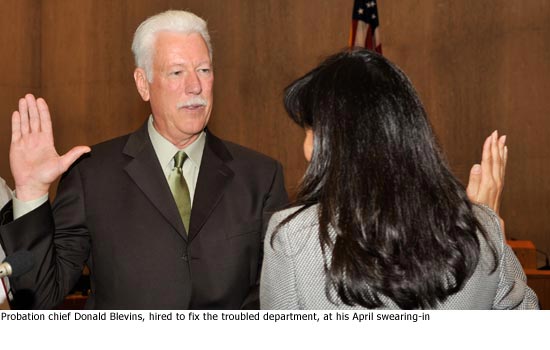



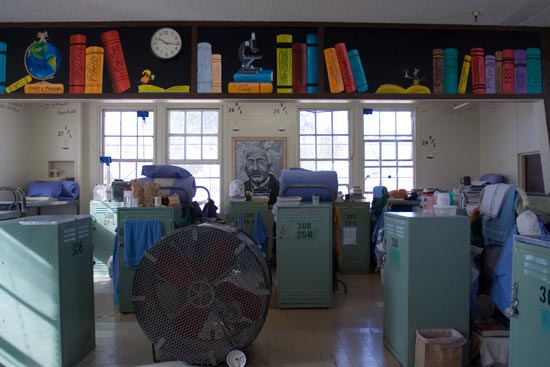

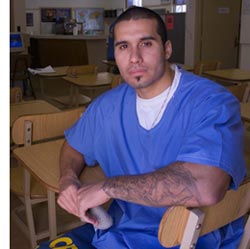







 405 bridge work causes a stink
405 bridge work causes a stink
